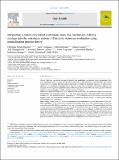| dc.contributor.author | Duamor, Christian | |
| dc.contributor.author | Hampson, Katie | |
| dc.contributor.author | Lankester, Felix | |
| dc.contributor.author | Lugelo, Ahmed | |
| dc.contributor.author | Changalucha, Joel | |
| dc.contributor.author | Lushasi, Kennedy | |
| dc.contributor.author | Czupryna, Anna | |
| dc.contributor.author | Mpolya, Emmanuel | |
| dc.contributor.author | Kreppel, Katharina | |
| dc.contributor.author | Cleaveland, Sarah | |
| dc.contributor.author | Wyke, Sally | |
| dc.date.accessioned | 2023-10-16T06:12:55Z | |
| dc.date.available | 2023-10-16T06:12:55Z | |
| dc.date.issued | 2023-06-03 | |
| dc.identifier.uri | https://doi.org/10.1016/j.onehlt.2023.100575 | |
| dc.identifier.uri | https://dspace.nm-aist.ac.tz/handle/20.500.12479/2309 | |
| dc.description | This research article was published in the One Health Volume 17, June 2023 | en_US |
| dc.description.abstract | Abstract: Sustained vaccination coverage of domestic dog populations can interrupt rabies transmission. How-
ever, challenges remain including low dog owner participation, high operational costs associated with current
(centralized and annually delivered (pulse)) approaches and high dog population turnover. To address these
challenges an alternative (community-based continuous mass dog vaccination (CBC-MDV)) approach was
designed. We investigated the potential for successful normalization of CBC-MDV into routine practice within the
context of local communities and the veterinary system of Tanzania
Methods: In a process evaluation of a pilot implementation of CBC-MDV, we conducted in-depth interviews with
implementers and community leaders (n = 24), focus group discussion with implementers and community
members (n = 12), and non-participant observation (n = 157 h) of delivery of the intervention components. We
analyzed these data thematically drawing on the normalization process theory, to assess factors affecting
implementation and integration.
Main findings: Implementers and community members clearly understood the values and benefits of the CBC-
MDV, regarding it as an improvement over the pulse strategy. They had a clear understanding of what was
required to enact CBC-MDV and considered their own involvement to be legitimate. The approach fitted well into
routine schedules of implementers and the context (infrastructure, skill sets and policy). Implementers and
community members positively appraised CBC-MDV in terms of its perceived impact on rabies and recommended
its use across the country. Implementers and community members further believed that vaccinating dogs free of
charge was critical and made community mobilization easier. However, providing feedback to communities and
involving them in evaluating outcomes of vaccination campaigns were reported to have not been done. Local
politics was cited as a barrier to collaboration between implementers and community leaders. | en_US |
| dc.language.iso | en | en_US |
| dc.publisher | Elsevier | en_US |
| dc.subject | Rabies | en_US |
| dc.subject | Process evaluation | en_US |
| dc.subject | Normalization process theory | en_US |
| dc.subject | Community-based | en_US |
| dc.subject | One Health | en_US |
| dc.subject | Vaccination coverage | en_US |
| dc.subject | Mass dog vaccination | en_US |
| dc.title | Integrating a community-based continuous mass dog vaccination delivery strategy into the veterinary system of Tanzania: A process evaluation using normalization process theory | en_US |
| dc.type | Article | en_US |

